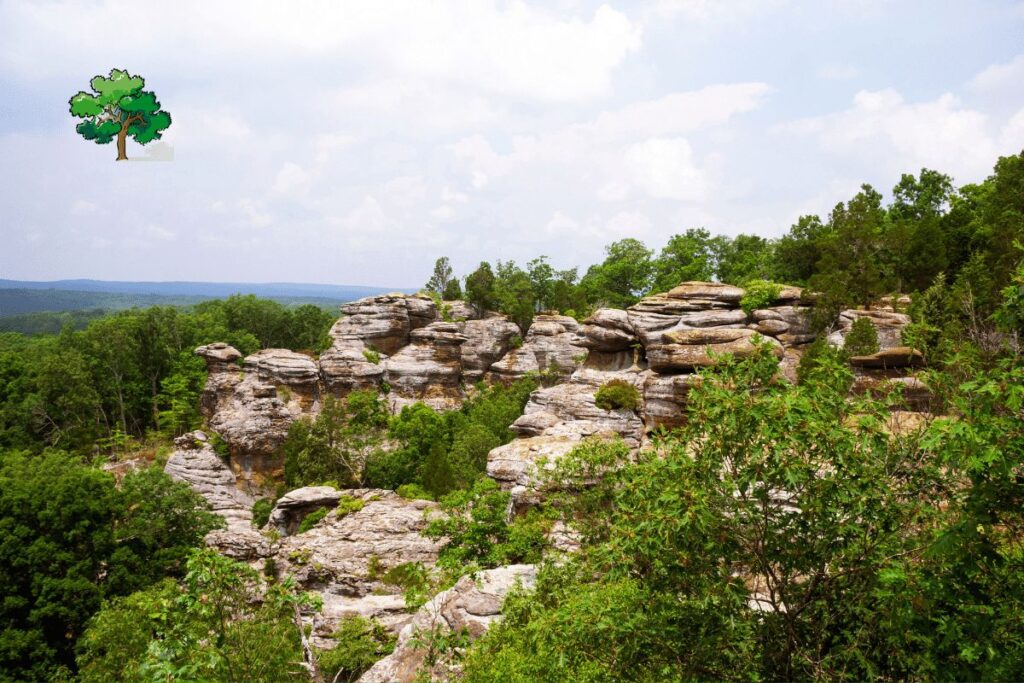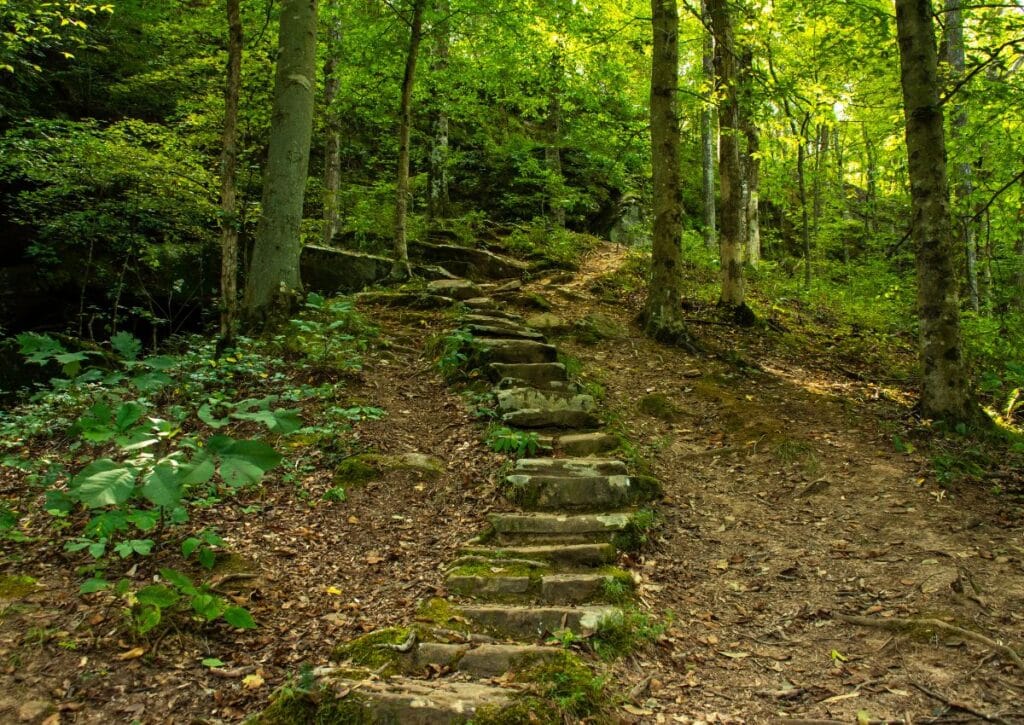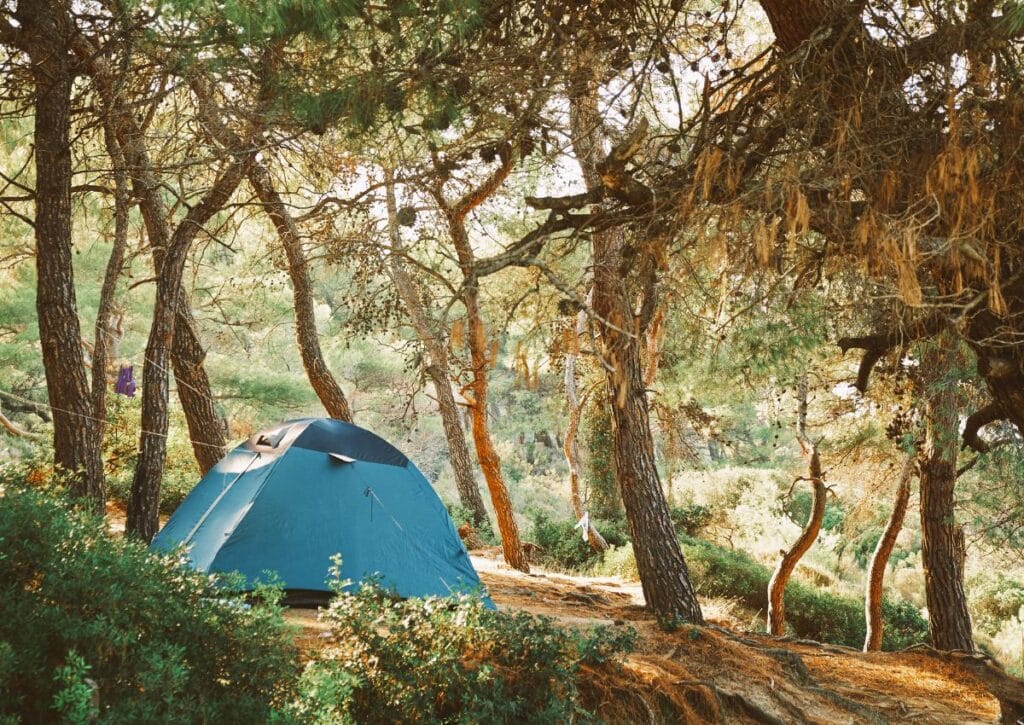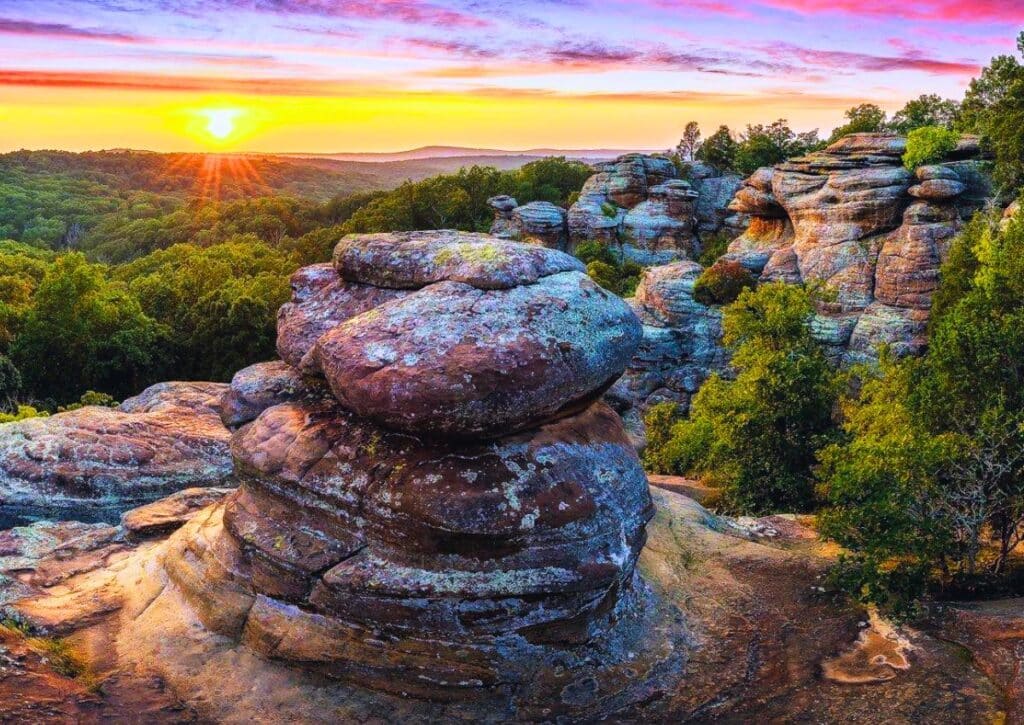Discover Shawnee National Forest Wilderness Areas: a guide to breathtaking landscapes, wildlife encounters, and outdoor activities for a wild adventure.
Have you ever wanted to escape the noise of the city and get lost in the pure wonders of nature?
Shawnee National Forest is the perfect place to immerse yourself in the wild. This vast expanse is home to some of the most breathtaking wilderness areas in the U.S.
From the majestic Garden of the Gods to the mysterious Bell Smith Springs, there’s a world of beauty waiting for you.
If you are a wildlife enthusiast like us, the chance to encounter wildlife and see them in their elements is what excites you the most! Wilderness areas in Shawnee off you just that.
Here is a guide to understanding Shawnee National Forest wilderness areas and the wildlife you might encounter!
9 Favorite Wilderness Areas in Shawnee National Forest
Shawnee National Forest is not just a vast expanse of greenery, but a collection of designated wilderness areas that preserve the natural beauty and diverse ecosystems of southern Illinois.
Each wilderness area, with its unique terrain and features, provides an unspoiled backdrop for both wildlife and adventure seekers.
Lets go into each with a little more detail:
Garden of the Gods
The Garden of the Gods stands out as a breathtaking marvel of nature.
Sculpted over millions of years by the forces of wind and water, its unique topography boasts a series of stunning rock formations that seem to defy gravity.
The reddish-brown sandstone outcrops and cliffs rise in various shapes and sizes, with names like “Camel Rock” and “Devil’s Smokestack,” offering visitors an otherworldly landscape to explore.

The Garden of the Gods isn’t just a geologist’s dream; it’s also a haven for wildlife. As you wander the trails, keep an eye out for white-tailed deer weaving through the trees, red-tailed hawks soaring overhead, and small critters like chipmunks and rabbits darting between the rocks.
For those keen on trekking, the Observation Trail is a must-do. At just a quarter-mile long, this moderately difficult trail offers some of the best views of the rock formations.
As you walk, interpretive signs provide insights into the history and geology of the area, making it an educational experience as well.
Camping enthusiasts can find solace in the Pharaoh Campground nearby.
Tucked amidst the trees and providing a rustic experience, it’s the perfect base for those wishing to spend a night under the stars after a day of exploration.
Tips for Exploring Garden of the Gods:
- Rock Safety: Many of the formations may seem tempting to climb, but not all are stable. Stick to designated climbing areas and be cautious of loose rocks.
- Capture the Sunrise or Sunset: The rock formations are especially photogenic during the golden hours of sunrise and sunset. Consider planning your visit around these times for spectacular views and photos.
- Check for Seasonal Restrictions: Some sections may be off-limits during particular times of the year to protect nesting birds or due to weather conditions.
- Optimal Viewing Spots: While the Observation Trail provides a fantastic vantage point, asking local guides or park rangers can lead you to less-known spots for unique views of the formations.
- Beware of Potholes: After rain, water collects in natural potholes on the rock surfaces. While they can be fascinating ecosystems to observe, they can also be slippery. Tread carefully.
With these specific tips in mind, visitors can ensure a safe, respectful, and enriching experience at the Garden of the Gods, truly one of Shawnee National Forest‘s crown jewels.
Bell Smith Springs
Bell Smith Springs, another gem in the Shawnee National Forest, is renowned for its captivating topography marked by a series of clear, vibrant springs and a collection of rock formations reminiscent of ancient architectural marvels.
These formations, carved over millennia, encompass deep canyons, towering cliffs, and delicate travertine springs, presenting a varied terrain that caters to both casual visitors and serious trekkers.
Diverse as its landscapes are, Bell Smith Springs is also a treasure trove of wildlife.
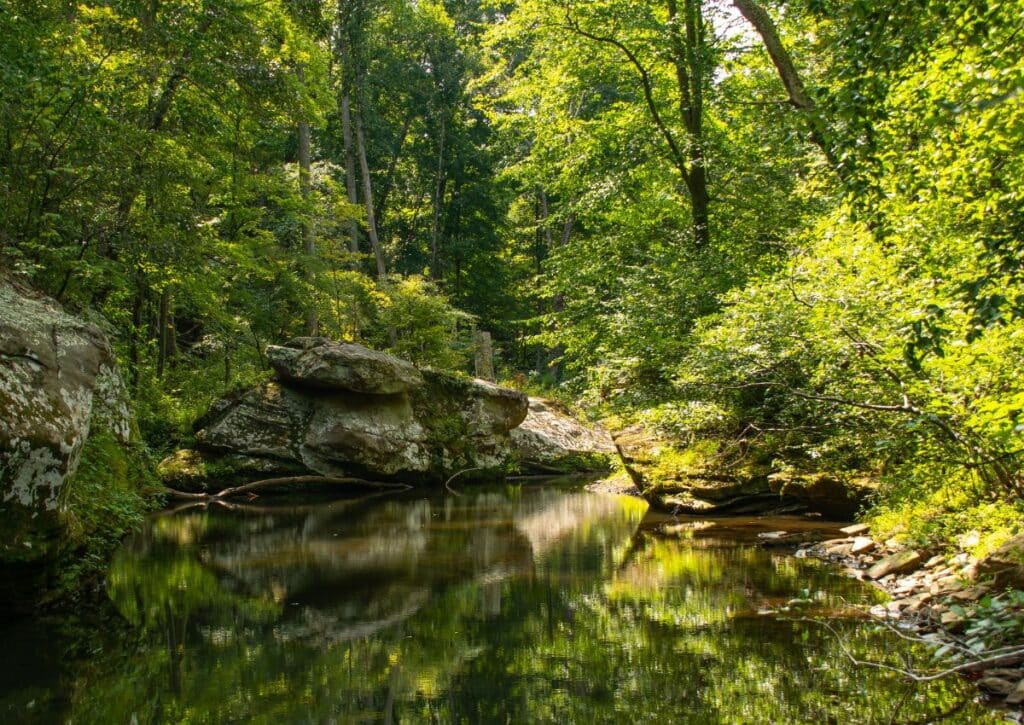
The pristine waters and dense forests are home to various species, such as the vibrant prothonotary warbler, the elusive gray fox, and vibrant aquatic life like the green sunfish. The glistening springs, reflecting the canopies above, are a hub for animals seeking respite and refreshment.
For those interested in hiking, the area boasts the 8-mile Bay Creek Trail, renowned for its diverse terrain, and the 1.5-mile Devil’s Backbone Trail, which offers views of the impressive rock formations and the serene springs.
Both trails provide an immersive experience, giving trekkers a close-up view of the region’s ecological diversity.
Nearby, the Camp Cadiz Campground stands as a welcoming retreat for those who wish to extend their stay.
Shaded under a canopy of towering trees, the campsite promises a peaceful night amidst the gentle sounds of nature.
Tips for Exploring Bell Smith Springs:
- Waterproof Footwear: With numerous springs and creek crossings, waterproof shoes can make your hike more comfortable.
- Be Cautious of Slippery Rocks: Especially near the springs, rocks can be slick. Ensure you’re steady on your feet when navigating these areas.
- Swimming Caution: While the springs are inviting, it’s essential to be aware of deep spots and currents. Always ensure you’re in designated swimming areas.
- Check for Trail Updates: Given the region’s dynamic nature, some trails might be closed off due to weather or maintenance. It’s always a good idea to check ahead.
- Observe Wildlife From a Distance: Especially in the spring and early summer, many animals are nurturing their young. Keep a respectful distance and avoid any interactions.
Bell Smith Springs stands as a testament to nature’s ability to create unparalleled beauty over time. Each trail, spring, and rock tells a story of a time long past, waiting to be explored and appreciated by those who tread its paths.
Bald Knob Wilderness
Spanning over 5,900 acres, the Bald Knob Wilderness area is characterized by its striking ridges, deep valleys, and dense hardwood forests.
The wilderness is named after Bald Knob, the second-highest point in Illinois, which serves as an iconic landmark and a beacon for adventurers and nature enthusiasts alike.
The terrain, a mix of uplands and lowlands, nurtures a varied palette of wildlife. It’s not uncommon for visitors to catch sight of the majestic bald eagles soaring overhead or hear the distant call of the eastern wild turkey.
The dense canopies provide refuge to creatures like the barred owl, and if one is lucky, a fleeting glimpse of the bobcat might grace your journey.
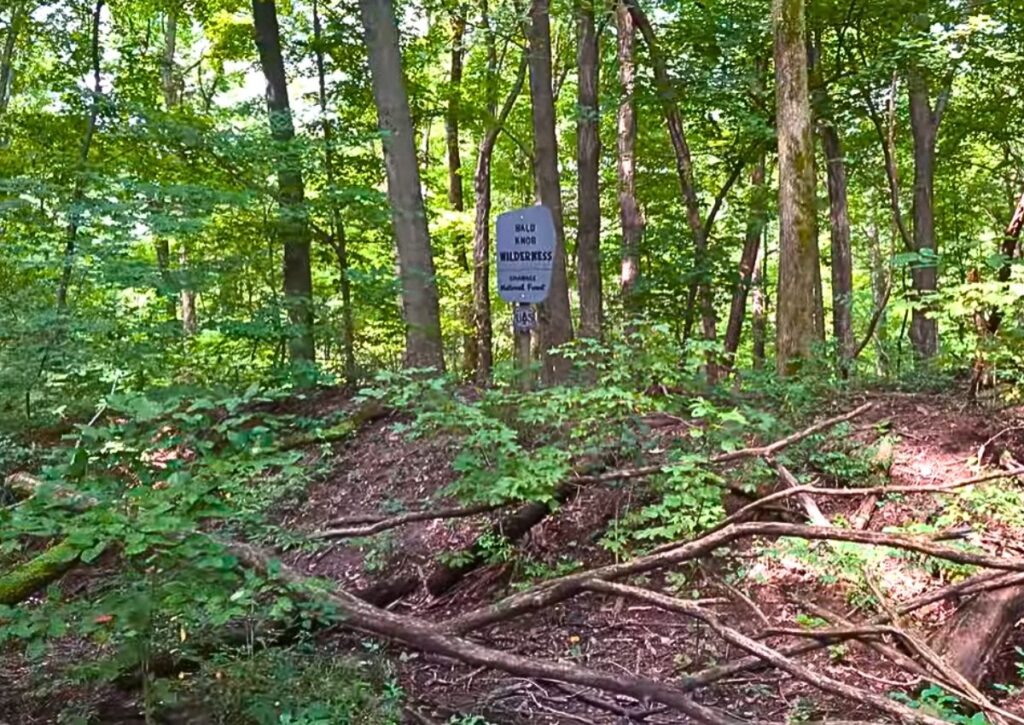
For those eager to explore, the Bald Knob Trail is a prominent path winding through the heart of the wilderness. This 5-mile looped trail is a moderate trek, with sections that provide panoramic views of the encompassing forests and the distant horizons.
While the wilderness exudes a sense of untouched beauty, it does not have designated campgrounds within its boundaries.
However, dispersed camping is permitted, allowing seasoned campers the experience of truly being one with nature, under the vast starlit sky.
Tips for Exploring Bald Knob Wilderness:
- Navigation Essentials: Given the raw nature of the wilderness, ensure you have a reliable map, compass, or GPS device.
- Pack for the Unexpected: Weather can be unpredictable. Always pack extra layers and rain gear, even if the day starts sunny.
- Stay Prepared for Dispersed Camping: If you plan to camp, remember there are no amenities. Bring everything you need, including water filtration methods and a leave-no-trace mindset.
- Beware of Poisonous Plants: The wilderness is home to plants like poison ivy. Familiarize yourself with what they look like and steer clear.
- Watch Out for Wildlife: While it’s thrilling to spot animals, remember they are wild. Maintain a safe distance and store food securely to avoid attracting them to your campsite.
A visit to Bald Knob Wilderness is akin to stepping back in time, to an era when nature reigned supreme.
The tranquility and vastness of the region beckon all who crave a deep connection with the Earth, making it an unforgettable destination in the heart of the Shawnee National Forest.
Panther Den Wilderness
Panther Den Wilderness, with its evocative name, is the smallest designated wilderness within the Shawnee National Forest, yet it’s filled with mysteries and wonders that disproportionately outweigh its size.
Covering just over 1,200 acres, it holds within its confines a landscape that is both enchanting and challenging.
At the heart of Panther Den Wilderness lies its namesake feature: Panther Den, a massive rock formation resembling a cave or a den.
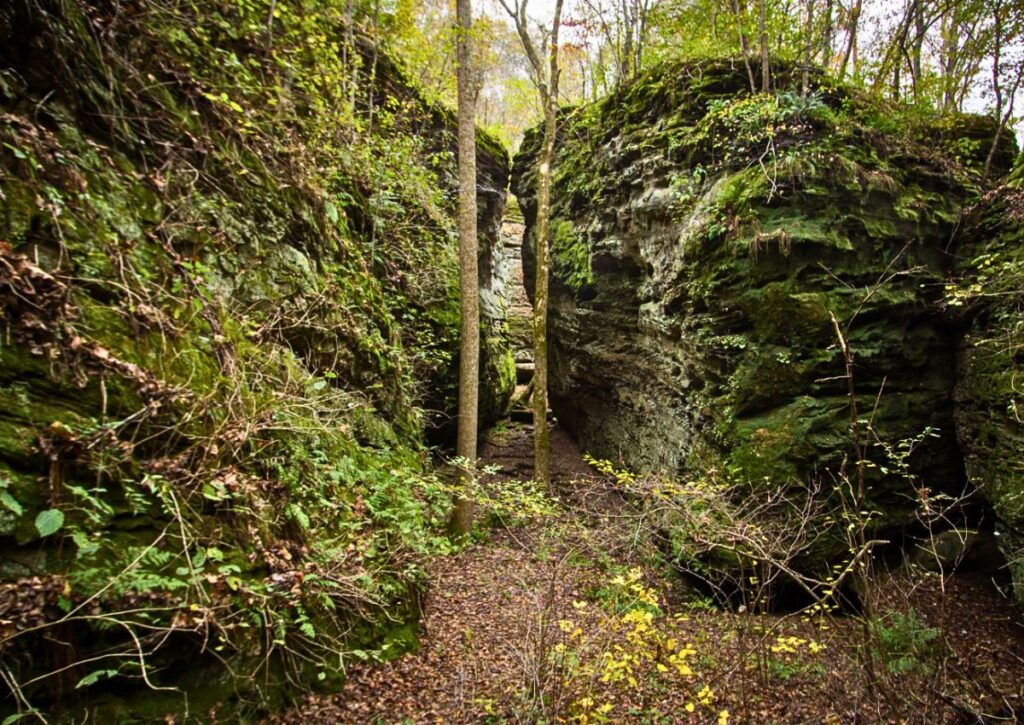
The rocks, twisted and turned by the hands of time, have sculpted corridors, overhangs, and chambers that seem almost otherworldly. It’s no wonder that local legends and tales have spun around this unique geological marvel.
Wildlife thrives in this protected enclave. It is a habitat for creatures like the wood thrush, whose melodic calls echo through the dense foliage, and the timber rattlesnake, which suns itself on the rocky outcrops.
Deer and foxes are common sights, moving silently among the trees, their presence often detected by the soft rustle of leaves.
For trekkers, the Panther Den Loop Trail, a 2.9-mile round trip, offers a delightful trekking experience.
The trail weaves through the dense hardwood forest, leading adventurers to the iconic Panther Den rock formation and its maze-like corridors.
While the wilderness does not have official campgrounds, dispersed camping provides an intimate experience for those wishing to immerse themselves fully in the wild ambiance.
Tips for Exploring Panther Den Wilderness:
- Rock Safety: Panther Den’s rock formations are intriguing, but some can be unstable. Always be cautious when exploring them.
- Water Sources: This wilderness doesn’t have many natural water sources. Carry ample water or be prepared to filter and purify any you find.
- Campfire Awareness: Due to its size and dense vegetation, be particularly careful with campfires. Ensure they’re fully extinguished before leaving.
- Trekking Poles: The terrain can be uneven with some steep sections. Trekking poles can provide extra stability.
- Listen for Wildlife: With its dense forests, you’re more likely to hear animals before you see them. Stay aware and enjoy these natural soundtracks.
Panther Den Wilderness is a testament to nature’s ability to pack diversity and wonder into even the smallest of spaces.
A visit promises a journey filled with discovery, introspection, and a deeper appreciation for the intricate tapestry of the natural world.
Lusk Creek Wilderness
A realm of serene beauty and rich biodiversity, the Lusk Creek Wilderness is a 6,293-acre expanse within the Shawnee National Forest.
This wilderness area boasts a wide array of distinctive landforms and captivating scenery, from dramatic limestone bluffs to the meandering waterways that have shaped the region over millennia.
One of the most striking features of Lusk Creek Wilderness is the Lusk Creek itself, which has diligently carved out canyons, cliffs, and caves in the bedrock, painting a landscape that feels both ancient and ever-evolving.
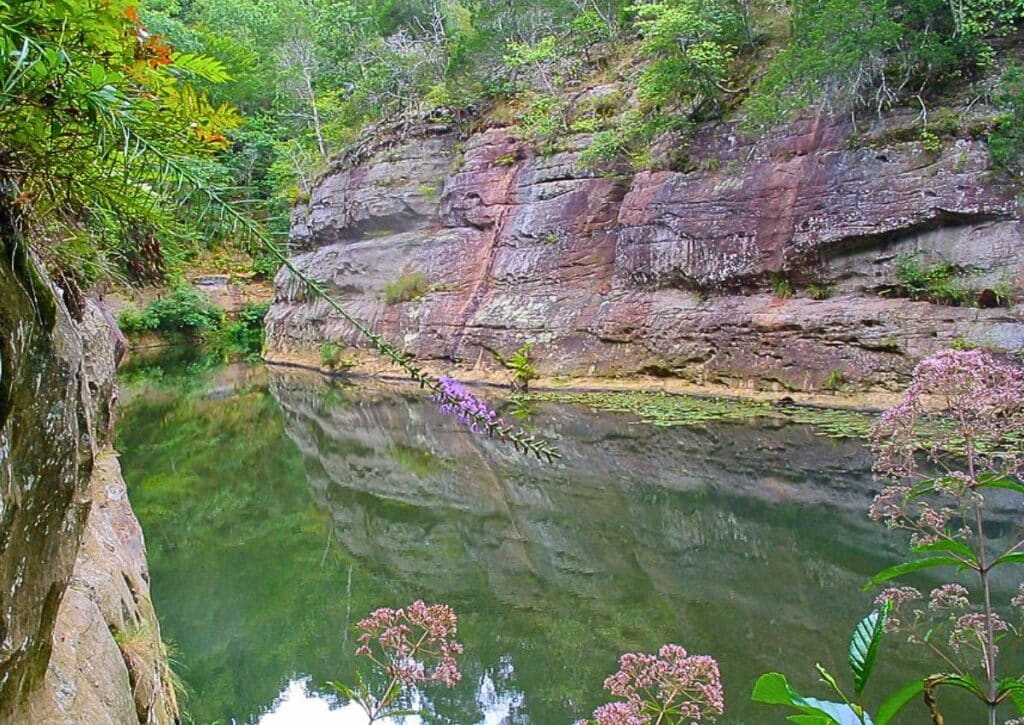
The creek’s waters, reflecting the canopy overhead, teem with life, supporting a variety of freshwater fish and providing a lifeline to the wilderness’s inhabitants.
The diverse habitats here are home to creatures like the prothonotary warbler, a bright yellow bird that flits among the trees, and the otter, which can occasionally be spotted gliding through the creek.
Majestic ospreys are known to hunt in these waters, their keen eyes ever watchful for a catch.
For those who seek to traverse this wilderness, the Lusk Creek Trail is a gem. This trail, stretching approximately 4.5 miles, offers hikers panoramic views of the area’s cliffs and valleys.
Meandering through dense forests and alongside the creek, it offers varying terrains, catering to both novice and experienced trekkers.
There are no established campgrounds within the wilderness boundaries, but dispersed camping allows visitors the freedom to find a quiet corner under the sprawling canopy, accompanied by the gentle gurgling of the creek.
Tips for Exploring Lusk Creek Wilderness:
- Water Footwear: With several creek crossings on the trail, it’s wise to have water-appropriate footwear to keep your trek comfortable.
- Fishing Gear: If you’re an angler, don’t forget your gear. The creek is a haven for various fish species. Remember to check local regulations.
- Stay on Designated Trails: The area has fragile ecosystems. Avoid creating new paths and stick to designated trails to minimize impact.
- Prepare for Elevation Changes: Some sections of the trail involve steep climbs or descents. Ensure you’re physically prepared and carry necessary gear.
- Check Water Levels: Before setting out, check water levels, especially if recent rains have occurred. Higher levels can make certain trail sections challenging.
The allure of Lusk Creek Wilderness lies in its pristine environment, its echoing silence interrupted only by the song of birds or the rustle of leaves.
Whether you’re a hiker, angler, or simply a nature enthusiast, this wilderness offers an experience of profound connection and wonderment.
Burden Falls Wilderness
Burden Falls Wilderness is a 3,775-acre haven of untouched nature and mesmerizing water features.
Named after its crown jewel, Burden Falls, this wilderness region beckons those who thirst for tranquility and the undisturbed symphony of the wild.
The cascading Burden Falls, dropping over a series of rocky ledges, is the centerpiece of this wilderness.
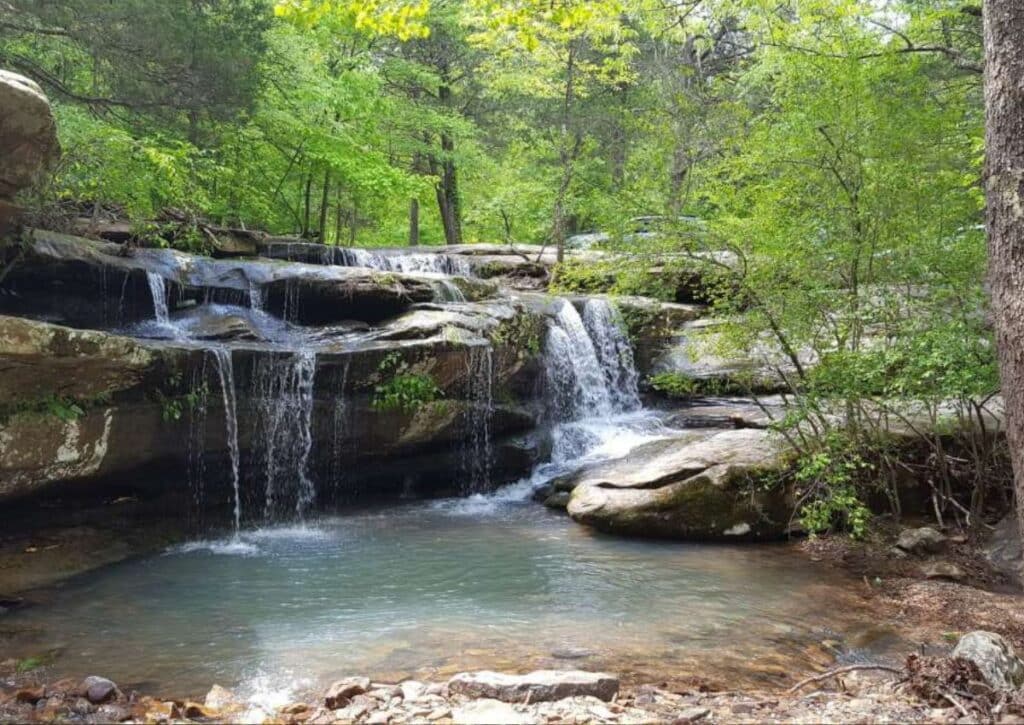
While it’s not the tallest waterfall in Illinois, its multi-tiered cascade set against a backdrop of dense forest creates a picturesque scene, especially after a heavy rain.
The landscape of Burden Falls Wilderness is a mix of upland forests and rugged bluffs. Here, animals like the barred owl, whose haunting calls fill the evening air, and elusive bobcats thrive in harmony.
The dense canopy and undulating terrain provide habitats for an array of creatures, both large and small.
Several trails lace the wilderness, with the most renowned being the Burden Falls Trail.
This relatively short trail, approximately 1.5 miles in length, leads directly to the falls. The path can be rocky and steep in places, but the reward of the cascading waters is well worth the effort.
Though there aren’t designated campgrounds in the area, dispersed camping is permitted. Setting up camp near the sound of the waterfall under a starlit sky is an experience many adventurers cherish.
Tips for Exploring Burden Falls Wilderness:
- Best Views After Rain: For the most spectacular waterfall views, plan your visit after a rainfall when the cascade is at its fullest.
- Caution Near The Falls: The area around the falls can be slippery, especially on wet days. Tread with caution and wear sturdy footwear.
- Stay Hydrated: Even on shorter trails, the terrain can be demanding. Carry enough water, especially during warmer months.
- Capture the Moment: If you’re into photography, early morning or late afternoon offers the best light to capture the falls’ beauty.
- Respect the Ecosystem: Remember to practice Leave No Trace principles to preserve the pristine nature of the wilderness for future generations.
Burden Falls Wilderness, with its harmonious blend of water and woodland, offers visitors an escape into a world where nature remains in its purest form.
Each footstep on its trails is an opportunity to reconnect with the Earth and rejuvenate the spirit.
Clear Springs Wilderness
Spanning 4,730 acres, Clear Springs Wilderness is a testament to nature’s grandeur and resilience.
This area, characterized by its hardwood forests and meandering streams, showcases a landscape touched only by the forces of nature and time.
Clear Springs Wilderness is awash with streams that feed into the Big Muddy River, creating lush riparian habitats.
Such environments support a rich biodiversity, with creatures like the rare Indiana bat and colorful songbirds thriving amidst the towering oaks and hickories.
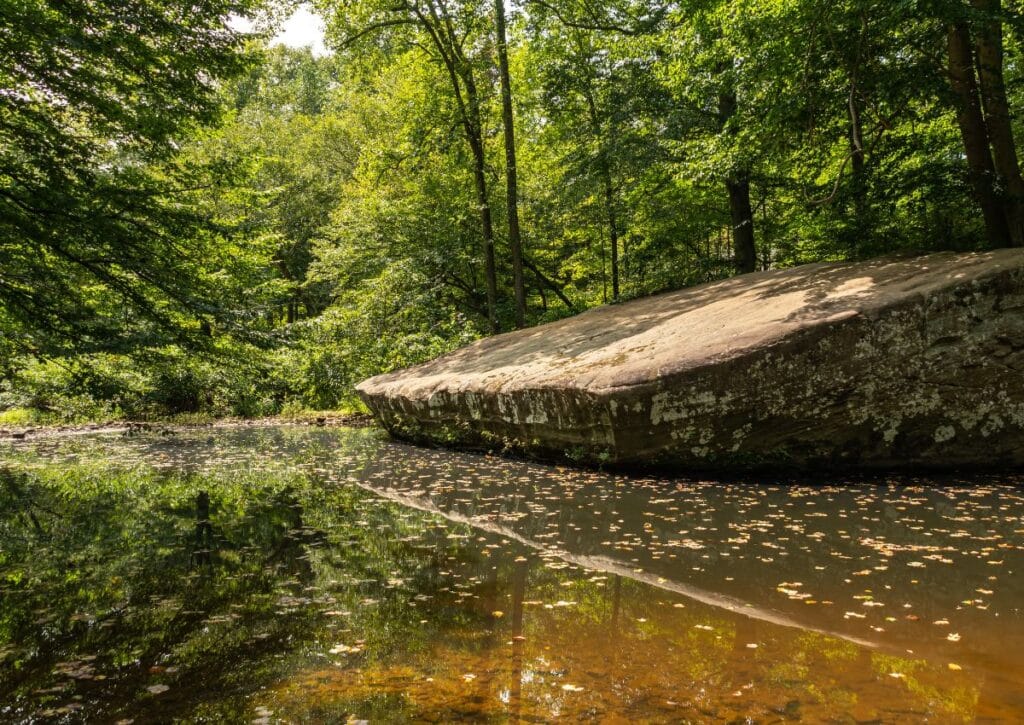
For trekkers, the 4-mile Clear Springs Trail offers an immersive journey through the wilderness, moving through dense woods, alongside springs, and over rolling terrain.
Dispersed camping is permitted, providing visitors a chance to sleep under the ancient canopy, lulled to rest by the whispering leaves.
Tips for Clear Springs Wilderness:
- Pack In, Pack Out: With no designated trash facilities, it’s crucial to take all waste with you.
- Footwear is Key: Expect muddy patches, especially near streams. Waterproof shoes will enhance your trek.
- Wildlife Watching: Dawn and dusk are optimal times to spot the resident wildlife in action.
LaRue Pine Hills Research Natural Area
Known for its stunning bluffs and diverse ecology, the LaRue Pine Hills covers approximately 4,070 acres.
But what truly sets it apart is its geological and biological significance. The region features unique limestone bluffs that tower above the Mississippi floodplain.
Throughout the seasons, the area becomes a corridor for reptilian migration, especially snakes.
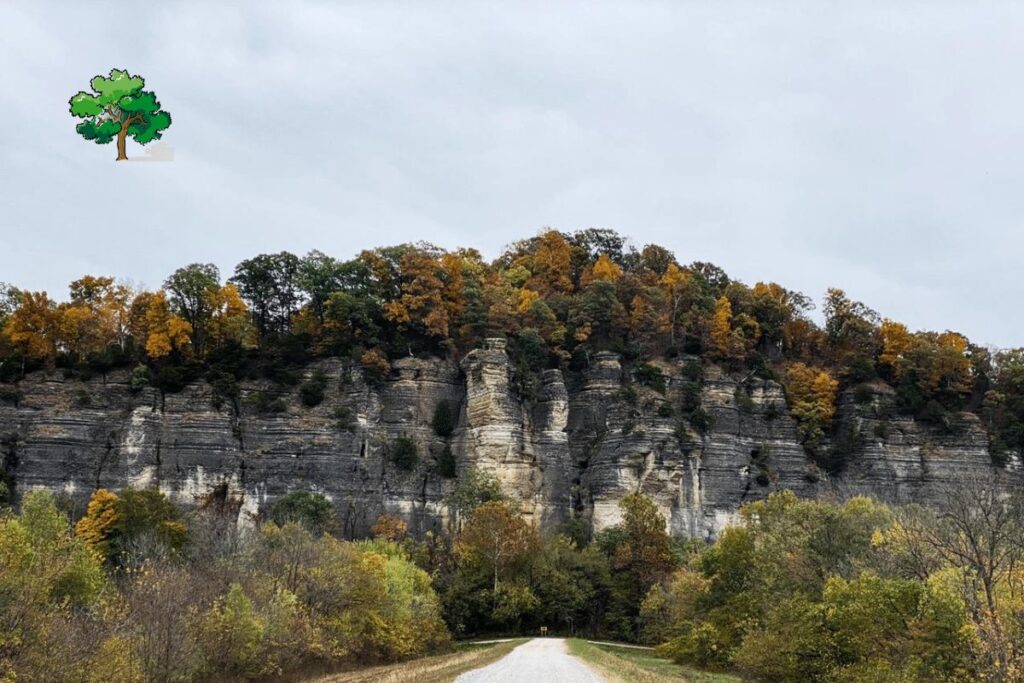
These creatures, along with other wildlife such as deer, eagles, and various amphibians, find sanctuary within the confines of the dense forests and wetlands.
A series of trails weave through the area, varying in length and difficulty, offering breathtaking views of the bluffs and the surrounding landscapes.
Tips for LaRue Pine Hills:
- Respect the Reptiles: Especially during migration, be cautious and respectful. Never harm or disturb the snakes.
- Stay on Designated Paths: To protect the unique flora and fauna, stick to the trails and avoid trampling sensitive areas.
- Visit in Spring: Witness the full bloom of wildflowers, painting the landscape in a palette of colors.
Little Grand Canyon
Don’t let the name mislead you; while not as vast as its famous namesake, the Little Grand Canyon offers its own brand of awe-inspiring vistas.
Located within the Shawnee National Forest, this 3,300-acre area presents a landscape of deep canyons, imposing cliffs, and cascading streams.
The erosion by the Big Muddy River has shaped the sandstone cliffs, creating the deep chasms that give the area its name. Wildlife enthusiasts might spot the agile white-tailed deer, red foxes, or even the occasional bobcat.
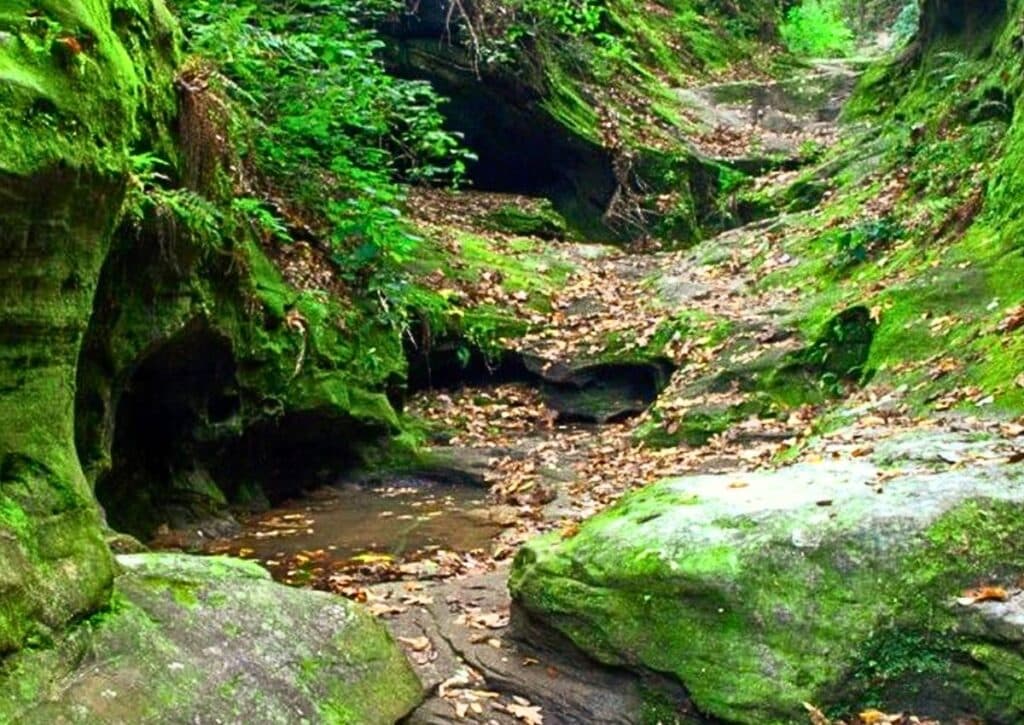
A highlight for many visitors is the Little Grand Canyon Trail, approximately a 3.6-mile loop, which descends into the canyon and then climbs back up, offering panoramic views.
Tips for Little Grand Canyon:
- Prepare for the Descent: The trail can be steep and challenging. Ensure you’re equipped with sturdy shoes and ample water.
- Seasonal Beauty: Autumn paints the canyon in fiery colors, while spring bursts with greenery and wildflowers.
- Safety First: Stay away from cliff edges and always keep an eye on children during the hike.
Wildlife Viewing in Shawnee National Forest
Shawnee National Forest is a wildlife enthusiast’s paradise. The vast expanse, dotted with lush greenery and water bodies, is home to a myriad of animal species waiting to be spotted by the observant traveler.
Within its wilderness areas like Garden of the Gods and Bell Smith Springs, one can find deer casually grazing, their white tails flicking as they move through the underbrush.
These areas, untouched and pure, often provide the best backdrop for wildlife sightings, as the animals feel safe in their natural habitats.
Birdwatchers find Shawnee particularly captivating. The forest is alive with the chirps, tweets, and songs of numerous bird species.
From the majestic red-tailed hawks soaring in the sky to the tiny warblers hiding in the thicket, there’s always a chance to spot something with wings.
Water birds, such as herons and kingfishers, can be seen around the forest’s ponds and streams, making for excellent photography opportunities.
On the forest floor, if one is quiet and patient, sightings of foxes, raccoons, and even the elusive bobcat are possible. The trick with these shy creatures is to tread softly and to avoid sudden movements.
Keep an eye out for movement in the bushes or the telltale glint of eyes reflecting the light.
But it’s not just about the larger mammals. Shawnee’s water bodies are teeming with amphibian life.
The croaking of frogs becomes a symphony in the evenings, and with a bit of searching, salamanders can be found under rocks and near moist areas.
However, wildlife viewing isn’t just about seeing the animals; it’s also about understanding their habitats and behaviors. Shawnee’s visitor centers offer resources and guided tours that help visitors know the best spots and times for wildlife viewing.
Early mornings and late afternoons are often the most fruitful times as many animals are active during these cooler parts of the day.
While in Shawnee, it’s essential to respect the home of these wild creatures. Always observe from a distance, never feed the animals, and tread lightly to minimize disturbance.
After all, the best wildlife experiences are those where nature continues uninterrupted, offering us a brief window into its world.
Tips for Viewing Wildlife in the Shawnee National Forest
1. Look for wildlife early in the morning or late in the evening, when they are most active.
2. Use binoculars or a spotting scope to get a closer look at animals from a distance.
3. Be patient and quiet while waiting for animals to appear. Sudden movements and loud noises will scare them away.
4. Bring along a field guide to help you identify the different species you see.
5. Take plenty of photographs or videos to share with your friends and family!
6. Stay on designated trails and obey posted wildlife viewing regulations.
7. Keep your distance from wildlife to keep them safe, and remember that it is illegal to feed or harass them in any way.
8. Always respect the habitats of animals, plants, and other living things by leaving no trace of your visit.
9. If you encounter a wild animal, remain calm and move away slowly.
10. Have fun! Wildlife watching is a great way to explore nature and appreciate the beauty of the Shawnee National Forest.
Activities in Shawnee National Forest
Shawnee National Forest offers a rejuvenating escape from urban life, inviting nature enthusiasts and adventurers to revel in its diverse landscapes.
With over 280,000 acres to explore, it’s a haven of recreational activities.
Here’s a quick look at what the Shawnee National Forest offers:
Camping & Cabins
In the embrace of towering trees, under a canopy of stars, the camping experience in Shawnee is truly unparalleled.
There are numerous campgrounds scattered throughout the forest, from primitive sites that allow you to get back to nature to more developed areas with amenities like picnic tables, fire rings, and restroom facilities.
For those wanting a touch of comfort while still being close to nature, the forest also offers rustic cabins.
These are perfect for families or groups, providing shelter, basic kitchen amenities, and a cozy setting to rest after a day of exploration.
Tips for Camping:
- Always check campground availability and potential restrictions, especially during peak seasons.
- Follow the ‘Leave No Trace’ principles, ensuring your camping spot is as pristine when you leave as when you arrived.
Fishing
The rhythmic sound of flowing water is never too far in Shawnee National Forest. With countless streams, rivers, and ponds, anglers have a multitude of choices.
The forest’s waters teem with a variety of fish, including bass, bluegill, catfish, and trout.
Whether you’re fly fishing in a serene stream or casting your line in a bustling river, the experience is meditative and rewarding.
Tips for Fishing:
- Ensure you have the necessary fishing permits and are aware of the state’s fishing regulations.
- Practice catch and release to help maintain healthy fish populations.
Hiking
The essence of Shawnee is best captured on foot. With over 403 miles of trails, ranging from gentle paths to challenging terrains, there’s a hike for everyone.
These trails navigate diverse landscapes—magnificent bluffs, deep canyons, tranquil waterfalls, and dense hardwood forests.
Iconic trails like the Garden of the Gods Recreation Area and the Little Grand Canyon Trail are not to be missed.
Tips for Hiking:
- Always inform someone about your hiking plans and estimated return time.
- Wear sturdy shoes, carry sufficient water, and be prepared for changing weather conditions.
Horse Riding & Camping
The allure of Shawnee isn’t just limited to those on foot. Equestrians can explore miles of bridle paths, taking in the forest’s beauty from a unique vantage point.
Several trails are designated specifically for horseback riding, ensuring a safe and enjoyable experience for both rider and steed.
After a long day of riding, there’s nothing like camping under the stars with your horse by your side. Shawnee offers designated horse camps with amenities like hitching posts, water sources, and spacious sites.
Tips for Horse Riding:
- Ensure your horse is fit and accustomed to the trail’s terrain.
- Always clean up after your horse to maintain the trail’s condition.
Hunting
Shawnee’s diverse ecosystem supports an array of wildlife, making it a popular destination for hunters. Deer, turkey, and squirrel are among the commonly hunted species.
The forest’s expansive landscape ensures that hunters can experience the thrill of the chase in a natural and challenging environment.
Tips for Hunting:
- Familiarize yourself with Illinois’ hunting regulations and seasons.
- Prioritize safety. Always wear visible clothing, preferably in bright orange, and be aware of other forest visitors.
Nature Viewing
For those who prefer a passive interaction with nature, Shawnee National Forest doesn’t disappoint. With over 300 species of birds, it’s a birdwatcher’s paradise.
The varied habitats also support mammals like bears, bobcats, coyotes, and white-tailed deer. Additionally, the forest bursts into colors with wildflowers in the spring, offering a visual feast for botany enthusiasts.
Photographers, in particular, will find countless opportunities to capture the forest’s changing moods—from misty mornings to fiery sunsets.
Tips for Nature Viewing:
- Carry binoculars and a field guide to enhance your viewing experience.
- Be patient and silent. Often, the most magical moments in nature come to those who wait.
The Shawnee National Forest, with its myriad activities, promises an immersive experience in nature.
Whether you’re casting a line in hopes of a big catch, hiking to the highest bluff to watch the sunset, or simply sitting by your campfire listening to the nocturnal symphony of the woods, Shawnee invites you to connect, explore, and rejuvenate.
Conclusion
Shawnee National Forest is a great place to visit if you’re looking for incredible wildlife viewing opportunities. With its vast array of habitats, the park has something to offer everyone. From hiking trails and camping sites to observation decks and overlooks, there are plenty of places where you can observe the diverse collection of animals in this unique part of Illinois. Whether you’re looking for birds, deer, or even bobcats, Shawnee National Forest has it all!

